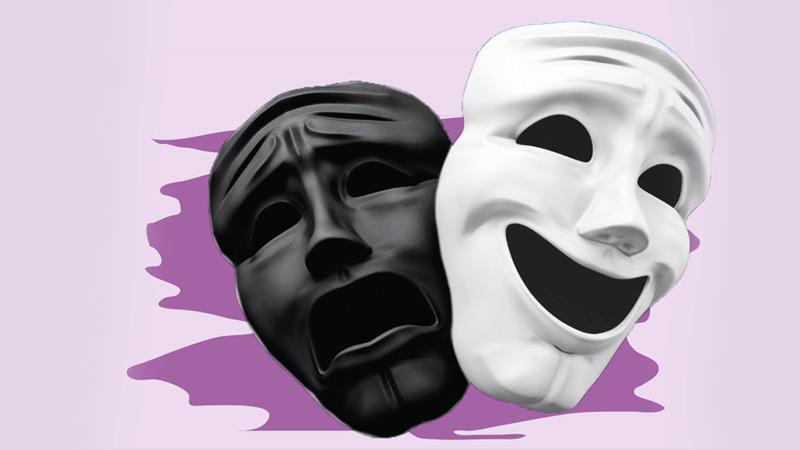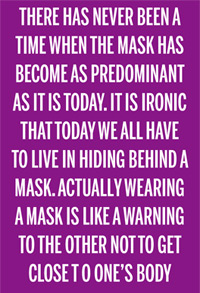
Fifteen years ago (the same column back in 2006) I wrote a column for the Daily News, the sister newspaper of The Sunday Observer, entitled Behind the mask. I am going to write that column to the Sunday Observer and I wonder how timely it is to write today.
There has never been a time when the mask has become as predominant as it is today. It is ironic that today we all have to live in hiding behind a mask. Actually wearing a mask is like a warning to the other not to get close to one’s body. More often we believe that this mask or face shield covers us with protection. The question is whether this mask covers our real self. In this writing I am confronted with that subjective problem. As I referred to in the first column of the Daily News there is nothing behind the mask. What has happened to masks is that we have been transformed in to weird people.
As a result, everyone wanders around the society wearing masks covering their faces.
Natural face
We have created a society where we do not physically know each other because the mask covers our so-called natural face. It is ironic that even those who have denied the rights of Muslim women who have covered their faces as a cultural right have had to wrap their faces around society. What has really happened is that the whole society has become a mask because of this organic connection with the mask.
 Stanley, the protagonist played by Jim Carrey in the movie The Mask, directed by Charles Russell (1994) is an idiot. Somehow, by chance, he encounters a mask that changes his life. When he puts on the mask, that stupidity runs away from him. After wearing this wooden mask, that was created by Loki, the Norse god of mischief, this meek bank employee turns into an eccentric and maniacal super hero who can bend reality. When wearing the mask, the protagonist felt an irresistible impulse. The hero himself put it in a desperate moment as follows:” I lose control –I can do anything I want”
Stanley, the protagonist played by Jim Carrey in the movie The Mask, directed by Charles Russell (1994) is an idiot. Somehow, by chance, he encounters a mask that changes his life. When he puts on the mask, that stupidity runs away from him. After wearing this wooden mask, that was created by Loki, the Norse god of mischief, this meek bank employee turns into an eccentric and maniacal super hero who can bend reality. When wearing the mask, the protagonist felt an irresistible impulse. The hero himself put it in a desperate moment as follows:” I lose control –I can do anything I want”
We read the Freudian theory of the mask as follows; “We all wear masks metaphorically speaking, we suppress the id, our darkest desire and adopt a more socially acceptable image”. What film demonstrate however is completely opposite; the id our darkest desires, dwell in the mask we put in. What should we understand if this reading is directed to our contemporary society? Even when we are doing good deeds, we are still wearing a mask.
Michael Jackson
Michael Jackson is one of the characters we cannot avoid when reading about the mask. Jackson showed that his symbolic appearance is attached to utmost pleasure. He saw changing the body as a means of removing obstacles to one’s happiness. Even the West sees his change of skin colour as a betrayal of his past by posing as a white man. So why did Michael even change his nose?
Michael Jackson was a child until his death, (Peter Pan complex) not to escape from his father, but to recognise the symbolic universe he introduced. For him, the mask is a signifier of his childhood father. As a child, Jackson’s father reportedly wore a face mask and jumped into the bedroom where he was sleeping. The father entered little Jackson’s room through the open window. It was his father’s law to close that window when he went to bed. Wearing a mask and breaking into the room through that window and frightening little Jackson was the punishment his father had given him for breaking that law. Jackson’s father explained that his goal was to teach that how a thief could enter through that window. So the mask was the inevitable imaginary signifier that controlled Jackson’s life
Michael Jackson turns his face into a mask, obeying his father’s law. The whitening of the skin was not a frenzy of being white, but a repetition of the lesson taught by the father when he was a child. In doing so, he sought to protect himself from enemies in the outside world (these enemies being his own fantasy is another matter). Michael is said to have feared that someone would abduct him after his father put on a mask and threatened him. He transforms his face into a mask because this fear has been with him all his life.
To Jackson, his father was the law of the primordial father. Therefore, it was imperative that the children obey this law. But the symbolic order (existence) or culture that Jackson encountered outside was different to his father’s law (language). There was an obscene law disguised as a civilised law.
The so-called civilised law of the symbolic father (the big other) is a calling to himself instead of the law of his father. On the one hand, spending money on behalf of lawyers can be seen as a violation of his real father’s obscene law. Changing the body, not only clashing with legal issues, but all his musical creations was a rebellion against his primordial obscene father. But what prevails is Jackson’s biological father’s obscene law. He mysteriously killed himself and confirmed his father’s victory.
Kieslowski
One other character I came across while exploring the mask metaphor was Krzysztof Kieslowski, a Polish film director. Kieslowski, who shifts from documentary to feature films, said that we can observe the truth better in fiction. According to him, tears obtained with glycerin are more real than real tears. In a sharp reading of Kieslowski’s cinema, Slavoj Zizek observes the connection between Kieslowski and the mask in his text The Fright of the Real Tears as follows:
“Is, then, Kieslowski’s point simply that wearing a mask should serve as a kind of protective shield, as the sign of respect for what should remain concealed? Or is it rather that Kieslowski is fully aware of the dialectic of ‘wearing a mask’? Our social identity, the person we assume to be in our intersubjective exchanges, is already a ‘mask’, it already involves the repression of our inadmissible impulses, and it is precisely in the conditions of ‘just gaming’, when the rules regulating our ‘real-life’ exchanges are temporarily suspended, that we can permit ourselves to display these repressed attitudes.”
Although there is a lot of talk about masks in relation to the name of this column, my aim is to create a conversation in the cultural sphere.
There we begin a discussion of contemporary trends in the arts, such as literature and cinema.
